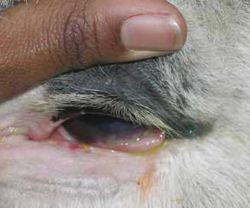Difference between revisions of "Entropion - Donkey"
Jump to navigation
Jump to search
m (Text replace - '|rspace={{Donkey}} |pagetype=Donkey }}' to '|pagetype=Donkey }} {{infotable |Maintitle = This section was sponsored and content provided by '''THE DONKEY SANCTUARY''' |Maintitlebackcolour = B4CDCD }} [[Cat) |
|||
| Line 26: | Line 26: | ||
|linkpage =Eyelid Diseases - Donkey | |linkpage =Eyelid Diseases - Donkey | ||
|linktext =Eyelid Diseases - Donkey | |linktext =Eyelid Diseases - Donkey | ||
| − | |||
|pagetype=Donkey | |pagetype=Donkey | ||
}} | }} | ||
| + | {{infotable | ||
| + | |Maintitle = [[Sponsors#The Donkey Sanctuary|This section was sponsored and content provided by '''THE DONKEY SANCTUARY''']] | ||
| + | |Maintitlebackcolour = B4CDCD | ||
| + | }} | ||
| + | [[Category:Donkey]] | ||
Revision as of 10:22, 25 February 2010
| This article has been peer reviewed but is awaiting expert review. If you would like to help with this, please see more information about expert reviewing. |
Signalment

Entropion is commonly found in old donkeys as a result of enophthalmos. In a new-born foal, congenital entropion will cause ocular irritation within days.
Diagnosis
- Close examination is needed to see if the inversion of the eyelid is causing the eyelashes to traumatise the cornea
- Fluorescein staining is essential to check for corneal ulceration
Treatment
- Most cases can be resolved by simply everting the eyelid, possibly on repeated occasions
- If manual eversion fails, mechanical eversion can be achieved by injecting saline subcutaneously.
- Temporary placement of 3/0 silk in a vertical mattress suture can be effective
- Severe cases may need surgical correction
References
- Grove, V. (2008) Conditions of the eye In Svendsen, E.D., Duncan, J. and Hadrill, D. (2008) The Professional Handbook of the Donkey, 4th edition, Whittet Books, Chapter 11
|
|
This section was sponsored and content provided by THE DONKEY SANCTUARY |
|---|